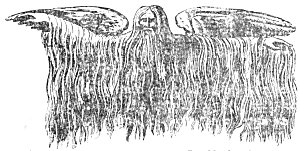p. 395
of the Goddess, and enchanting sights and sounds, mingled with songs and dances, exalted the communicant to a rapture of supreme felicity, realizing, as far as sensuous imagery could depict, the anticipated reunion with the Gods.
In the dearth of direct evidence as to the detail of the ceremonies enacted, or of the meanings connected with them, their tendency must be inferred from the characteristics of the contemplated deities with their accessory symbols and mythi, or from direct testimony as to the value of the Mysteries generally.
The ordinary phenomena of vegetation, the death of the seed in giving birth to the plant, connecting the sublimest hopes with the plainest occurrences, was the simple yet beautiful formula assumed by the great mystery in almost all religions, from the Zend-Avesta to the Gospel. As Proserpina, the divine power is as the seed decaying and destroyed; as Artemis, she is the principle of its destruction; but Artemis Proserpina is also Core_ Soteria, the Saviour, who leads the Spirits of Hercules and Hyacinthus to Heaven.
Many other emblems were employed in the Mysteries,–as the dove, the myrtle-wreath, and others, all significant of life rising out of death, and of the equivocal condition of dying yet immortal man.
The horrors and punishments of Tartarus, as described in the Phædo and the Æneid, with all the ceremonies of the judgments of Minos, Eacus, and Rhadamanthus, were represented, sometimes more and sometimes less fully, in the Mysteries; in order to impress upon the minds of the Initiates this great lesson,–that we should be ever. prepared to appear before the Supreme Judge, with a heart pure and spotless; as Socrates teaches in the Gorgias. For the soul stained with crimes, he says, to descend to the Shades, is the bitterest ill. To adhere to Justice and Wisdom, Plato holds, is our duty, that we may some day take that lofty road that leads toward the heavens, and avoid most of the evils to which the soul is exposed in its subterranean journey of a thousand years. And so in the Phædo, Socrates teaches that we should seek here below to free our soul of its passions, in order to be ready to enter our appearance, whenever Destiny summons us to the Shades.
Thus the Mysteries inculcated a great moral truth, veiled with a fable of huge proportions and the appliances of an impressive spectacle, to which, exhibited in the sanctuaries, art and natural
p. 396
magic lent all they had that was imposing. They sought to strengthen men against the horrors of death and the fearful idea of utter annihilation. Death, says the author of the dialogue, entitled Axiochus, included in the works of Plato, is but a passage to a happier state; but one must have lived well, to attain that most fortunate result. So that the doctrine of the immortality of the soul was consoling to the virtuous and religious man alone; while to all others it came with menaces and despair, surrounding them with terrors and alarms that disturbed their repose during all their life.
For the material horrors of Tartarus, allegorical to the Initiate, were real to the mass of the Profane; nor in latter times, did, perhaps many Initiates read rightly the allegory. The triple-walled prison, which the condemned soul first met, round which swelled and surged the fiery waves of Phlegethon, wherein rolled roaring, huge, blazing rocks; the great gate with columns of adamant, which none save the Gods could crush; Tisiphone, their warder, with her bloody robes; the lash resounding on the mangled bodies of the miserable unfortunates, their plaintive groans, mingled in horrid harmony with the clashings of their chains; the Furies, lashing the guilty with their snakes; the awful abyss where Hydra howls with its hundred heads, greedy to devour; Tityus, prostrate, and his entrails fed upon by the cruel vulture; Sisyphus, ever rolling his rock; Ixion on his wheel; Tantalus tortured by eternal thirst and hunger, in the midst of water and with delicious fruits touching his head; the daughters of Danaus at their eternal, fruitless task; beasts biting and venomous reptiles stinging; and devouring flame eternally consuming bodies ever renewed in endless agony; all these sternly impressed upon the people the terrible consequences of sin and vice, and urged them to pursue the paths of honesty and virtue.

Moe is the founder of GnosticWarrior.com. He is a father, husband, author, martial arts black belt, and an expert in Gnosticism, the occult, and esotericism.





